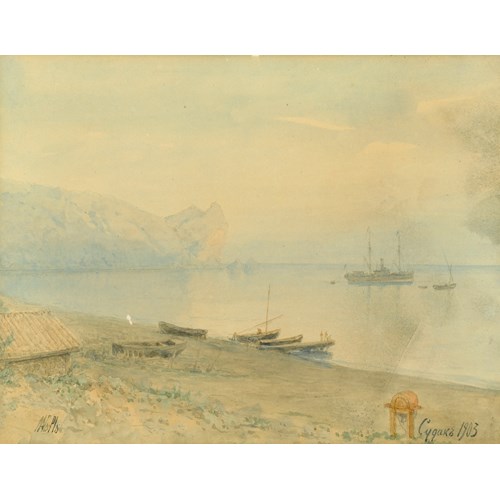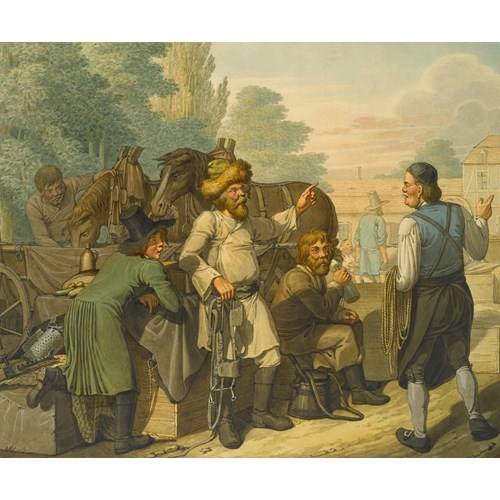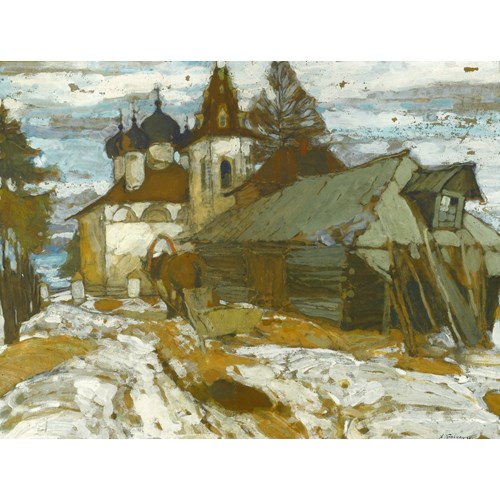Marketplace
A Landscape with a View over the Black Sea
Paul von Franken
A Landscape with a View over the Black Sea
Date 1854
Period 1850-1900, 19th century
Origin Germany
Medium Oil on canvas
Dimension 47 x 68 cm (18¹/₂ x 26³/₄ inches)
This painting shows a community on the edges of the Black Sea. Central to the composition is a sailing boat, moored to a small jetty, approached by two figures holding nets. Inside the boat, figures make final adjustments to the sails. On the shore nearby is a thatched stone building with several people seated outside. A village sits on the promontory behind, whilst a mountain range dominates the background. Though the exact location is not known, it is perhaps the Georgian coast as Paul von Franken and his wife moved to Tiflis in 1853. Von Franken’s time living in Georgia instilled in him a life-long affinity for the people, culture and landscape of the country, which continued to be the principal subject he illustrated throughout his career.
A Landscape with a View over the Black Sea is a classic seascape, but it is also a genre scene presenting the slightly romanticised activities of everyday life. The painting presents a coastal idyll; the sailing boat loaded for a future fishing expedition, a small laden rowboat making its way back to the shoreline leaves a glistening wake. The figures boarding the boat all wear costumes typical of nineteenth-century Georgia and the Caucasus, in particular the elongated black hats. On the nearby shore, figures sit in the sand and watch over the activity.
Von Franken has created a sense of drama with the dark misty clouds being whipped up from the water towards the mountains, suggesting a change in weather is imminent. He successfully intimates a large sense of space: the lower edge of the canvas is framed by a smattering of rocks, and the promontory guides the viewer’s eye to the mountains, whilst the large expanse of water, interrupted by a large boulder, is seen shimmering in the distance.
The Black Sea and its environs was a popular subject with artists working in the area in the nineteenth century. The inland sea, bordered by south-eastern Europe, the Pontic mountain range, the Caucasus and the Turkish peninsula provided artists with a plethora of differing vistas for inspiration. As an important shipping lane it was constantly busy with marine activity, and the varied coastline punctuated with mountain ranges, ports and small fishing villages were frequently represented by artists such as Ivan Konstantinovich Aivazovsky. One of Aivazovsky’s greatest works is said to be The Black Sea where the power and force of the choppy water stands alone as the subject. Though Aiviazovsky’s The Black Sea and von Franken’s A Landscape with a View over the Black Sea differ in composition and style, both elevate the body of water by highlighting the luminosity on the water’s surface and, by connecting the sea and sky above, they emphasise the vast space that extends beyond the limits of the canvas.
The Black Sea was the scene of considerable maritime hostilities during the Crimean War (1853-1856), notably at the port city of Sevestopol in Crimea. It is interesting that the present work, completed in 1854, depicts a romanticised coastal landscape when severe and bloody fighting was taking place nearby. Von Franken would surely have been aware of the conflict, and perhaps conceived of the present work as the antithesis to the horrors of warfare nearby, choosing to present a charming, peaceful coastal scene.
Von Franken, a genre and landscape painter, was born in 1819 in Oberbachem near Godesberg. His family had used the noble name ‘von Franken’ illegitimately since 1826, and despite a Cologne judge banning the use of this title, Paul von Franken continued to sign documents and paintings with this dignified suffix. He trained at the Dusseldorf Academy of Arts, and spent the period from 1842 to 1845 in Brussels and Antwerp, exhibiting at the Dresden Academy in 1846. Later he worked as a teacher where he met his Latvian wife Helene Korber. The couple lived for a year in her hometown of Jelgava (Mitau), and then moved to Tiflis in 1853 travelling through St. Petersburg and Moscow on the way. Though von Franken returned to work in Dusseldorf eight years later in 1861, he frequently returned to Tiflis and the Caucasus to paint and draw, taking the images and inspiration from Georgia back to his studio in Germany.
Though he produced many paintings in 1884, the year of his death, many are believed to have been completed by Helene Korber at a later date. After his death, his wife took all of the Caucasian paintings completed by von Franken back to Tiflis to be distributed amongst the wider family, where many still remain today.
A Landscape with a View over the Black Sea is a classic seascape, but it is also a genre scene presenting the slightly romanticised activities of everyday life. The painting presents a coastal idyll; the sailing boat loaded for a future fishing expedition, a small laden rowboat making its way back to the shoreline leaves a glistening wake. The figures boarding the boat all wear costumes typical of nineteenth-century Georgia and the Caucasus, in particular the elongated black hats. On the nearby shore, figures sit in the sand and watch over the activity.
Von Franken has created a sense of drama with the dark misty clouds being whipped up from the water towards the mountains, suggesting a change in weather is imminent. He successfully intimates a large sense of space: the lower edge of the canvas is framed by a smattering of rocks, and the promontory guides the viewer’s eye to the mountains, whilst the large expanse of water, interrupted by a large boulder, is seen shimmering in the distance.
The Black Sea and its environs was a popular subject with artists working in the area in the nineteenth century. The inland sea, bordered by south-eastern Europe, the Pontic mountain range, the Caucasus and the Turkish peninsula provided artists with a plethora of differing vistas for inspiration. As an important shipping lane it was constantly busy with marine activity, and the varied coastline punctuated with mountain ranges, ports and small fishing villages were frequently represented by artists such as Ivan Konstantinovich Aivazovsky. One of Aivazovsky’s greatest works is said to be The Black Sea where the power and force of the choppy water stands alone as the subject. Though Aiviazovsky’s The Black Sea and von Franken’s A Landscape with a View over the Black Sea differ in composition and style, both elevate the body of water by highlighting the luminosity on the water’s surface and, by connecting the sea and sky above, they emphasise the vast space that extends beyond the limits of the canvas.
The Black Sea was the scene of considerable maritime hostilities during the Crimean War (1853-1856), notably at the port city of Sevestopol in Crimea. It is interesting that the present work, completed in 1854, depicts a romanticised coastal landscape when severe and bloody fighting was taking place nearby. Von Franken would surely have been aware of the conflict, and perhaps conceived of the present work as the antithesis to the horrors of warfare nearby, choosing to present a charming, peaceful coastal scene.
Von Franken, a genre and landscape painter, was born in 1819 in Oberbachem near Godesberg. His family had used the noble name ‘von Franken’ illegitimately since 1826, and despite a Cologne judge banning the use of this title, Paul von Franken continued to sign documents and paintings with this dignified suffix. He trained at the Dusseldorf Academy of Arts, and spent the period from 1842 to 1845 in Brussels and Antwerp, exhibiting at the Dresden Academy in 1846. Later he worked as a teacher where he met his Latvian wife Helene Korber. The couple lived for a year in her hometown of Jelgava (Mitau), and then moved to Tiflis in 1853 travelling through St. Petersburg and Moscow on the way. Though von Franken returned to work in Dusseldorf eight years later in 1861, he frequently returned to Tiflis and the Caucasus to paint and draw, taking the images and inspiration from Georgia back to his studio in Germany.
Though he produced many paintings in 1884, the year of his death, many are believed to have been completed by Helene Korber at a later date. After his death, his wife took all of the Caucasian paintings completed by von Franken back to Tiflis to be distributed amongst the wider family, where many still remain today.
Date: 1854
Period: 1850-1900, 19th century
Origin: Germany
Medium: Oil on canvas
Signature: Signed with monogram and dated ‘1854’ (lower centre).
Dimension: 47 x 68 cm (18¹/₂ x 26³/₄ inches)
More artworks from the Gallery









